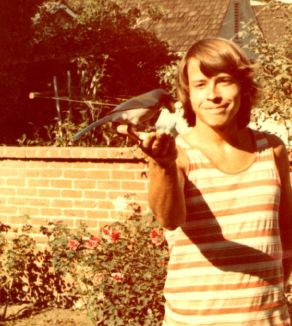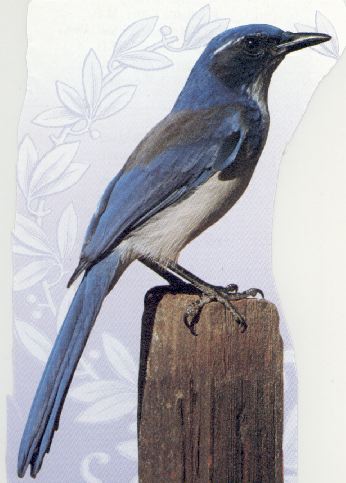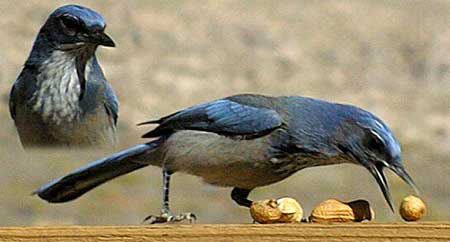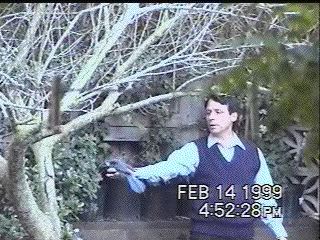Bluebirds are Free
Lessons about Equality
and Respect in Relationships
taught by a Scrub Jay
by Douglas Dunn
Copyright (c) 1999, 2000 Douglas Dunn
/ Word Wizards communications -- all
rights reserved
Shortly after I moved into a newly-purchased home in Oceanside,
California, in 1991, I was enjoying our back yard garden and saw
a pair of bluebirds in the bushes. Okay, they were not actually
true bluebirds (Eastern, Sialia sialis; Western,
Sialia mexicana; or Mountain, Sialia currocoides);
really they were California scrub jays (Aphelocoma californica),
but they were birds and their color was blue so I called 'em bluebirds
and the nickname stuck.
Bluebirds from the Past. Quickly
my thoughts returned to my late teen years. After keeping parakeets
and pigeons during my early teen years, by the time I was in high
school and college, busily distracted in studies, work and social
life, I stumbled across an alternative that required less day-to-day
responsibility than keeping birds as household pets.
While in college, I observed wild scrub jays perched in the
trees and sitting on the phone lines around my house. Each morning
when I left, and each evening when I returned, I would throw a
handful of peanuts on the back yard lawn, and the bluebirds would
swoop down for the free feast as soon as I closed the sliding
glass door. This allowed me to surround myself with birds without
the mandatory responsibilities.
|
One day I waited in the open doorway after throwing the peanuts
onto the lawn. With some hesitation, the birds fluttered down
and took the peanuts. Eventually I closed the door and remained
out on the lawn with them and, little by little, I moved closer
to where they picked up their free goodies, until I was very
near them.
Finally, I sat on the ground and held the peanuts in my hand,
low enough so they could safely snatch the peanuts from the ground.
At this they balked mightily, but eventually one of them tried
it and was rewarded with her usual treat. [As I would learn in
later years, it is the female scrub jays that learn to take treats
from the hand, because males offer such treats to females during
their courtship, so the females become receptive to such offerings
while the males perceive those who make such offers as rivals.]
I gradually raised my hand higher and higher until she had to
alight on my hand to get her freebie.
This was too much for most of the birds. But one individual
would come and sit comfortably on my hand, taking as long as
necessary to cram two peanuts into her beak.
As time passed, she would sit in the tree or overhead phone
lines and, when she saw me coming, would swoop down and, at the
last instant, tilt back and alight ever so gently upon my open
palm.
|

The author in 1972 holding his "bluebird buddy" |
She even learned to take peanuts from inside my mouth, though
would do so quickly instead of lingering as she did on my hand.
Imagine the trust required to put her tiny body inside the mouth
of a monster-sized being like me -- that's really working for
peanuts! [Note: I did this some thirty years ago, but would not
consider that today for reasons of health -- for both myself and
the bird.]
Occasionally, an observer would suggest that all I would have
to do to "catch" a bird was to close my hand while she
was sitting on it. I am sure it would not have been difficult
to "catch" her that way. But to "keep" her
after such a betrayal of trust would have required a cage. And
no matter how delightful the feathered "trophy," it
would have meant the loss of my real treasure -- that in her voluntary
assent, I had "captured" her heart and soul, not her
body. As long as she remained free, she remained mine in a sense
that no cage could ever hold her.
She remained my companion for about six years, even after I
moved out and only came back for occasional visits. It seemed
almost like she recognized my car and knew that if it was parked
in front of the house, she might find a "hand out" that
she could alight upon to take her free goodies. If I didn't bring
my peanut treats out into the yard promptly enough, she would
hop right up next to the sliding glass door and rap her beak against
it to summons me. Eventually, though, she stopped coming to the
yard. I no longer found her waiting for me up on the telephone
lines, or calling for me at the door, and I never knew what became
of her.
Since childhood, I had "owned" many birds. But none
was as special as this little bluebird, because I knew she came
to me of her own free choice. There was no possessiveness or ownership.
I never even gave her a name, which would have been an act of
dominion. And I never had a better "pet."
Relationship Lessons. She also
taught me some memorable lessons. I learned that the essence of
relationships is not in ownership or domination, but in wholly
voluntary attraction and sharing. While I have loved, enjoyed
and cared for the many birds I have purchased and kept as pets,
I was always conscious of the fact that they were "mine"
because I bought and paid for them. Though many were allowed to
fly free, our associations were not of their voluntary choosing
and, in some form, they were kept mine through some form of "cage."
The ultimate victory in relationships, as I would often ponder
over the years, was to create a condition so attractive that another
sentient being comes to you and stays with you entirely by its
own choice.
|
True, no matter how much effort we may expend, not every person
we encounter will be attracted to us. Just like thebirds: some
birds will respond easily, some slowly, and some will never overcome
their fear of potential predators. When we encounter those that
respond slowly or not at all, we may experience disappointment
at the failure. But if we resort to coercion in relationships
-- if we go chasing after the bird -- we might catch it, but
it will never be the free and beautiful relationship we sought;
we also acknowledge the failure to achieve the ultimate success
in relationships based on relating to others through wholly
voluntary attraction. So it is also with the humans we wish to
interact with. If we chase them and close our hands around them,
they will never be ours, at least not in any real sense. Birds
are not equal to human beings, but like people, they are social
yet they still value their autonomy and freedom. If you coerce
them, they will back away and retreat; if you respect their space
they might alight upon your hand (or they might not ... after
all, they are free.
I further considered that species such as scrub jays that
are gregarious and social can be easily tamed, while others that
are aloof and individualistic cannot. I thought about our own
species. Humans are social animals. Like the birds that congregate
in flocks, or other animals grouped in herds or packs, we have
an inherent need for companionship. Yet we are also quiet, contemplative
and solitary. For example, as much as I enjoy social events,
participation in civic activities or rallying behind my favorite
cause, I also love to curl up with a favorite book or sip my
morning coffee in quiet aloneness with my morning newspapers.
|
 |
Humans are both solitary and social. Our private selves need
to be free, like the bluebirds, to make private choices and take
individual risks that lead to rewards and opportunities. Our communal
essence must attend to matters of public policy that involve others.
An ideal sense of community is one in which private, personal,
individual pursuits are left to private, personal, individual
discretion while those affairs that involve the way we treat others
are handled as matters of public or community policy.
My Bluebirds Today. Returning
to the present from my rememberances of teen-aged years, I looked
again at my new neighbors flitting around the bushes. Soon after
discovering these bluebirds at our new home, I began to toss peanuts
out into the yard.

Photo by Larry Blakely |
Gradually, I began to linger in the yard as they
gathered their treasures. Slowly I moved closer. Eventually,
one bold female would come very near my hand, and finally she
would take a peanut directly from my hand while perching on a
pedestal that I set up in my back yard. Unlike my bluebird from
decades ago who quickly learned to alight on my hand and linger,
this female took more than a year of patient gentleness before
she would alight directly upon my hand. But still, she has overcome
her instinctive fear of another large creature because I have
been able to create a situation in which attraction, earned through
patient gentleness, outweighs apprehension. |
And for birds like these, that is no small feat. We must
remember that they are fearful and nervous with good reason: when
a small, delicate, non-threatening (non-predatory) creature has
the ability to fly, nervousness is a distinct
evolutionary advantage. So at least for now, she comes quickly,
takes her treat, and flits away as fast as she can. However, she
is able to express her desire for my attention (read: food) by
seeking me out when she does not readily see me out in the yard.
She often searches out my bedroom window (on the other side of
the yard), peering in to look for me. If she finds me there and
makes "eye contact," she flits over to the back door
where she knows I will promptly emerge with her hand-fed treats.
Will she ever linger upon my hand to await a second peanut?
That is something, I suppose, that only she will be able to
decide.
Facts about scrub jays:
Scrub jays have been shown through experimental evidence to
display an amazing spatial intelligence, and the ability to remember
where they have stored surplus food supplies such as nuts, acorns
or other durable foodstuffs -- often returning to hiding places
years later, and even after using hundreds of other hiding places.
In addition to nuts, scrub jays enjoy a wide variety of food sources
including fruits and insects (including wasps and spiders) and
sometimes even eggs from other birds, small rodents or other small
creatures! Their diverse diet allows them the ability to thrive
in a wide variety of environments, from forest to scrub to becoming
ubiquitous in suburban neighborhoods!
These birds were once thought to range from coast to coast,
but now have two distinct areas of range: the southwestern United
States and Florida. These populations do not mix and do not migrate
widely, but are year-round residents where found.
The book "Bird Brains," a Sierra Club book by Candace
Savage, which investigates the behavior of jays and crows (they're
in the same family, and among the most intelligent of bird species)
also talks about scrub jays' unusual use of "helper"
birds in managing the nest: young mature birds from previous seasons'
clutches who stay around to help the parent birds raise the new
hatchlings ... and in the process perhaps gain some nesting skills
for their own future broods.
Scrub jays are about 10" to 12" in length and usually
appear alone or in small groups of up to four birds, not in large
flocks.
Scrub Jays in San Diego County, California
Western Scrub Jays are ubiquitous year-round residents throughout
all parts of San Diego County (and the rest of Southern California
for that matter). Because their diverse diet includes fruits,
nuts, seeds, insects, and even small animals such as mice, they
can and do occupy a wide range of habitats from forest to scrub
to urban and suburban neighborhoods. They exist in huge numbers
and there is no need to keep a list of sightings as they are seen
many times each day in every part of the county.
Birding resources in North San Diego County,
California
San Diego Bird List: online discussion group for San
Diego County birders:
http://www.egroups.com/community/SDBIRDS.
Buena Vista Audubon Society -- 2202 South Coast Highway
(P.O. Box 480), Oceanside, California 92049. Phone: 760/439-BIRD
(2473).
Local chapter of the national Audubon Society for Oceanside and
Carlsbad (North County Coastal). Premises includes excellent visitors
center (no admission charge, but donatins gratefully accepted)
with extensive collection of taxidermy created from many species
of local birds and other wildlife.
Website: http://www.audubon.org/chapter/ca/buenavista.
Palomar Audubon Society -- P.O. Box 2483, Escondido,
California 92033. Phone: 858/487-4831.
Local chapter of the national Audubon Society for Escondido (North
County Inland).
Website: http://palomaraudubonsociety.homestead.com/index.html.
The Birdwatcher -- 2775 "B" Street, P.O. Box
388, Julian. Phone: 760/765-1817. http://www.the-birdwatcher.com/
This is a large, lovely shop filled with excellent resources for
birders or those who wish to attract birds to their yards, including
books, maps, supplies, knick-knacks, feeders and feed, and just
about anything else you can think of. A birder's dream come true.
Wild Birds Unlimited -- 2624 El Camino real, Carlsbad.
Phone: 760/720-1906. http://stores.wbu.com/carlsbad.
Attractive shop with feeders, bird seed, books and garden supplies
for those wishing to attract wild birds to their yards.
Wild Bird Center -- 1283 Encinitas Blvd., Encinitas
(Henry's/McDonald's Shopping Center). Phone: 760/334-6001.
Attractive shop with feeders, bird seed, books, birding equipment
and garden supplies for those wishing to attract wild birds to
their yards.
Bluebird Video (Free)
[Requires version 3 or higher of QuickTime plug-in for Mac
or Windows -- can be downloaded free at: http://www.apple.com/quicktime/download/index.html]

Video footage by Thelma Mantos Dunn
Click here or on picture
to view or download a free (recently taken) 5-second video (288k)
of the bluebird taking a peanut from my hand.
[Requires version 3 or higher of QuickTime plug-in for Mac
or Windows -- can be downloaded free at: http://www.apple.com/quicktime/download/index.html]
Copyright (c) 1999, 2000 Douglas Dunn
/ Word Wizards communications
Link to USGS official summer breeding distribution map:
USGS
map -- http://www.mbr-pwrc.usgs.gov/bbs/htm96/map617/ra4810.html.
-- U.S. Geological Survey -- Summer Distribution Map
Link to Doug's waxwing page: http://www.wordwiz72.com/waxwing.html
Doug's Personal bird lover's web page:
Bird Whisperer or Bird Brain?
Doug's life time love affair with birds is chronicled with picturers of
interactions with both wild and domesticated birds, from childhood
through adulthood.
New birding tool available:
I have discovered, bought and downloaded some excellent - amazing,
really - new tools to enhance my birding experience! As the happy owner
of the Apple iPhone, I was pleased to learn that a complete field guide was available for downloading from iTunes to my iPhone!
It was iBird Plus for the iPhone, which I downloaded last December (and subsequently received TWO FREE UPGRADES!)
More recently, a more advanced edition has been released, iBird PRO for the iPhone. I have since downloaded and installed iBird PRO and it is amazing.
In addition to numerous pictures, maps and information for each bird,
there are excellent search features to identify birds within seconds,
and one of my favorite features in the actual bird sounds! No more
trying to explain a sound to a novice birder, or looking at a
description in the field guide text trying to figure out what fzreeep
really sounds like!
By the way, I have no connection to the developer (Mitch Waite Group) other than being a very satisfied customer.
More information at: http://www.ibirdexplorer.com/product_finder.html.
We welcome FEEDBACK! Send e-mail feedback to: feedback.
Please note, be sure to BEGIN
the TITLE of your e-mail reply with the word "feedback"
to avoid having your e-mail deleted unread with all the other
junk e-mail that is mass deleted.
+More Articles:
Check out additional articles
by Douglas Dunn now available as FREE DOWNLOADS -- with additional
articles being added regularly, each one an adaptation of those
that have been published in mainstream newspapers and magazines
[more articles].
Books by Douglas
Dunn (click on book titles for descriptions of books and ordering
information):
--Dazhan.
--Extro-Dynamics.
Books written by Douglas Dunn may
also be ordered online through Barnes
and Noble, Borders.com
and/or Amazon.com.Also available
through other retail bookstores (if not in stock may be "special
ordered").
Return to Word Wizards home page



